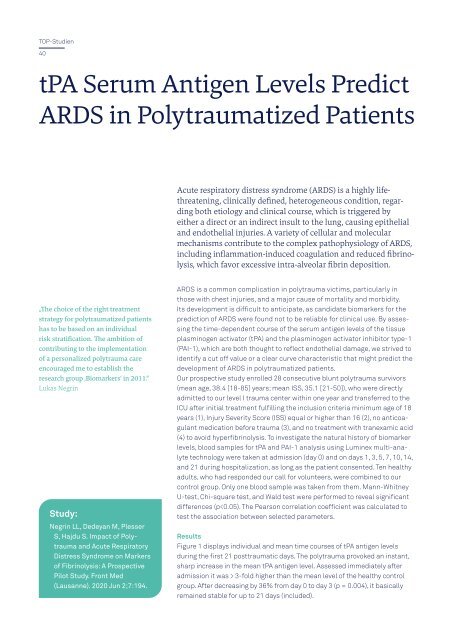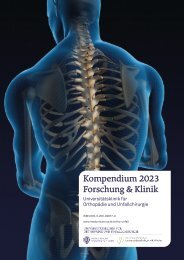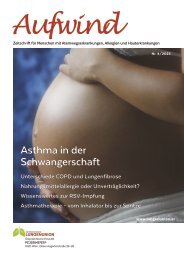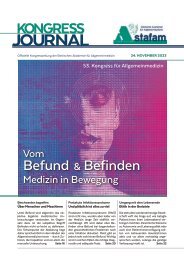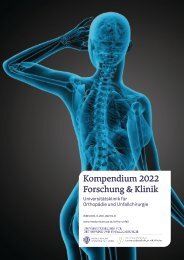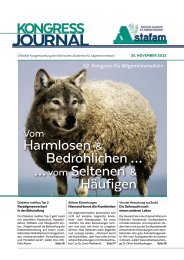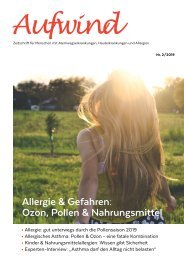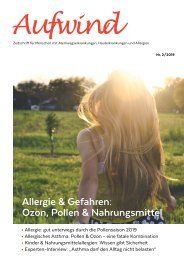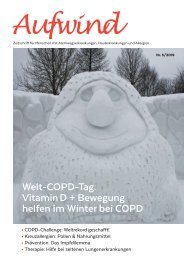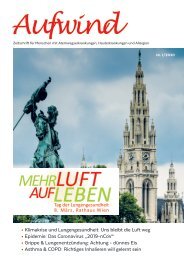Kompendium 2020 Forschung & Klinik
Das Kompendium 2020 der Universitätsklinik für Orthopädie und Unfallchirurgie von MedUni Wien und AKH Wien (o. Univ.-Prof. R. Windhager) stellt einen umfassenden Überblick über die medizinsichen Leistungen und auch die umfangreichen Forschungsfelder dar. Die Veröffentlichungen zeigen die klinische Relevanz und innovative Ansätze der einzelnen Forschungsrichtungen. Herausgeber: Universitätsklinik für Orthopädie und Unfallchirurgie MedUni Wien und AKH Wien Prof. Dr. R. Windhager ISBN 978-3-200-07715-7
Das Kompendium 2020 der Universitätsklinik für Orthopädie und Unfallchirurgie von MedUni Wien und AKH Wien (o. Univ.-Prof. R. Windhager) stellt einen umfassenden Überblick über die medizinsichen Leistungen und auch die umfangreichen Forschungsfelder dar. Die Veröffentlichungen zeigen die klinische Relevanz und innovative Ansätze der einzelnen Forschungsrichtungen.
Herausgeber: Universitätsklinik für Orthopädie und Unfallchirurgie
MedUni Wien und AKH Wien
Prof. Dr. R. Windhager
ISBN 978-3-200-07715-7
You also want an ePaper? Increase the reach of your titles
YUMPU automatically turns print PDFs into web optimized ePapers that Google loves.
TOP-Studien<br />
40<br />
tPA Serum Antigen Levels Predict<br />
ARDS in Polytraumatized Patients<br />
Acute respiratory distress syndrome (ARDS) is a highly lifethreatening,<br />
clinically defined, heterogeneous condition, regarding<br />
both etiology and clinical course, which is triggered by<br />
either a direct or an indirect insult to the lung, causing epithelial<br />
and endothelial injuries. A variety of cellular and molecular<br />
mechanisms contribute to the complex pathophysiology of ARDS,<br />
including inflammation-induced coagulation and reduced fibrinolysis,<br />
which favor excessive intra-alveolar fibrin deposition.<br />
„The choice of the right treatment<br />
strategy for polytraumatized patients<br />
has to be based on an individual<br />
risk stratification. The ambition of<br />
contributing to the implementation<br />
of a personalized polytrauma care<br />
encouraged me to establish the<br />
research group ‚Biomarkers‘ in 2011.“<br />
Lukas Negrin<br />
Study:<br />
Negrin LL, Dedeyan M, Plesser<br />
S, Hajdu S. Impact of Polytrauma<br />
and Acute Respiratory<br />
Distress Syndrome on Markers<br />
of Fibrinolysis: A Prospective<br />
Pilot Study. Front Med<br />
(Lausanne). <strong>2020</strong> Jun 2;7:194.<br />
ARDS is a common complication in polytrauma victims, particularly in<br />
those with chest injuries, and a major cause of mortality and morbidity.<br />
Its development is difficult to anticipate, as candidate biomarkers for the<br />
prediction of ARDS were found not to be reliable for clinical use. By assessing<br />
the time-dependent course of the serum antigen levels of the tissue<br />
plasminogen activator (tPA) and the plasminogen activator inhibitor type-1<br />
(PAI-1), which are both thought to reflect endothelial damage, we strived to<br />
identify a cut off value or a clear curve characteristic that might predict the<br />
development of ARDS in polytraumatized patients.<br />
Our prospective study enrolled 28 consecutive blunt polytrauma survivors<br />
(mean age, 38.4 [18-85] years; mean ISS, 35.1 [21-50]), who were directly<br />
admitted to our level I trauma center within one year and transferred to the<br />
ICU after initial treatment fulfilling the inclusion criteria minimum age of 18<br />
years (1), Injury Severity Score (ISS) equal or higher than 16 (2), no anticoagulant<br />
medication before trauma (3), and no treatment with tranexamic acid<br />
(4) to avoid hyperfibrinolysis. To investigate the natural history of biomarker<br />
levels, blood samples for tPA and PAI-1 analysis using Luminex multi-analyte<br />
technology were taken at admission (day 0) and on days 1, 3, 5, 7, 10, 14,<br />
and 21 during hospitalization, as long as the patient consented. Ten healthy<br />
adults, who had responded our call for volunteers, were combined to our<br />
control group. Only one blood sample was taken from them. Mann-Whitney<br />
U-test, Chi-square test, and Wald test were performed to reveal significant<br />
differences (p 3-fold higher than the mean level of the healthy control<br />
group. After decreasing by 36% from day 0 to day 3 (p = 0.004), it basically<br />
remained stable for up to 21 days (included).


